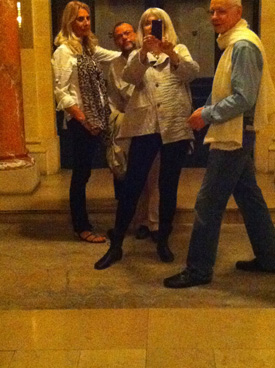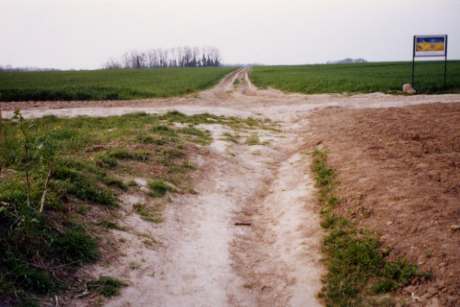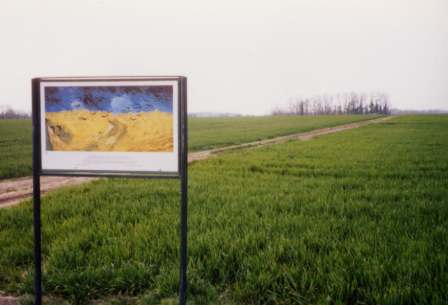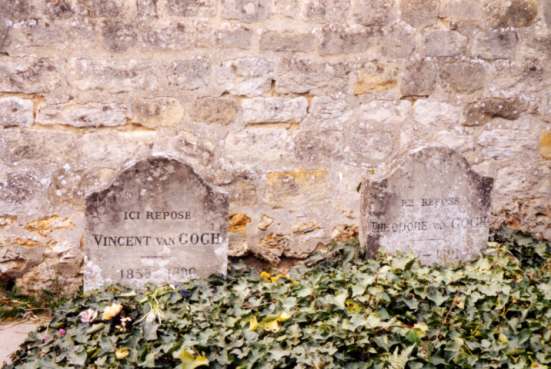HOTEL
HOTEL LUXEMBOURG PARC
42 Rue de Vaugirard
01.53.10.36.50
FOOD STORE
LA GRANDE EPICERIE DE PARIS
38 Rue de Sevres
PATISSIERS (Macarons)
PIERRE HERME
72 rue Bonaparte
LADUREE
16 rue Royale
21 rue Bonaparte
GERARD MULOT
76 rue de Seine
BAKERIES
LE PETITE LUX (apricot croissant with pastry cream!)
29 Rue de Vaugirard
PIZZA
PIZZA CHIC
13 Rue de Mezieres
01 45 48 30 38
FOOD STORES: CHOCOLATE
PERFUME
FREDERIC MALLE
37 rue de Grenelle
01.42.22.77.22
TRAVEL LETTERS – PARIS – 9.98
Our stay in the Marais area was perfect. We saw most of the other districts and none seemed as livable and authentic (or as centrally located) as the Marais. The hotel was about 5 blocks from the Place des Vosges and 2 blocks from the Jewish quarter.
Did you know that the croissant, a wonderful pastry in Paris and usually dreadful in the U.S, means waxing moon?
We spent an afternoon at the Cimetiere Pere Lachaise, the most romantic cemetery I have ever seen (in fact, the only romantic cemetery I know). We have been reading Balzac’s La Cousine Bette and Les Illusions Perdues and wanted to see his tomb (by the way, if you have not read these two incredible novels I strongly recommend that you begin tonight). It is not easy to find specific tombs due to the immense size of the property and the winding hilly paths. After much searching we found the monuments for Balzac, Rossini, Colette, Gertrude Stein and Oscar Wilde. Except for the Wilde tomb, none were venerated. This surprised me. I know if I lived near Balzac’s tomb I’d lay a flower there every week. Wilde’s monument is an art deco gem by Jacob Epstein with lots of vistors leaving pebbles behind. A massive winged Egyptian flies across the front while on the back of the stone is inscribed: AND ALIEN TEARS WILL FALL FOR HIM, PITY’S LONG BROKEN URN, FOR HIS MOURNERS WILL BE OUTCAST MEN AND OUTCASTS ALWAYS MOURN.
We managed to be in Paris for Les Journees Du Patrimoine when buildings normally closed to the public are thrown open at no charge. This of course results in long lines at the most unexpected places. We had the good fortune to witness a blazing example of American tourism at its most subtle. We were standing in line to ascend the tower of Notre Dame when in front of us a visitor from the midwest started complaining loudly about the French and their food, i.e. his wife’s steak tartare which she was sure was undercooked. He refused to pay when the cook would not heat it further and was chased to his hotel after refusing to pay. We thought we were finished with him when we climbed to the top. Not long after we arrived he came huffing and puffing out of the stairwell loudly announcing “Is this all there is here?” Maria, ever the kind traveler, asked him what he meant since the view of Paris at our feet was so impressive. He said, with a truly puzzled look on his face, “But where’s the Mona Lisa?”
TRAVEL LETTERS – FONTAINEBLEAU – 9.99
We’re just back from a trip to Paris, Reims and Fontainebleau. The purpose of the viaggio was a surprise 50th birthday party at Gerard Boyer’s Les Crayeres restaurant in Reims. That was an intense treat but the revelation of the trip was Fontainebleau and its surrounding forest and villages. I planned to visit the Chateau de Fontainebleau because of its Italian Renaissance art treasures (i.e. works by Rosso Fiorentino, Benvenuto Cellini and other Italiani) but discovered much more. The small city of Fontainebleau is less than an hour south of Paris (by train or car) but a world away in its sensibilities. It is surrounded by the great Foret of Fontainebleau which heavily influenced French landscape painting. The village of Barbizon (as in the Barbizon school) is nearby, where the visitor is immersed in the history of Millet (the Angelus), Corot and their compatriots. Just to the south is Moret-Sur-Loing with its Sisley associations evoked by the well-preserved riverfront views of ancient stone bridges and churches. These two villages make for sweet side trips, but the soul of the Foret is the great Chateau of Fontainebleau and the city which faces it. We stayed in Fontainebleau four days. Our practice is to remain in small art cities long enough to meet and become familiar with the locals. It is a pleasure to walk into the cafe in the morning, hear your name in greeting and receive your coffee perfectly prepared as you ordered it the previous day.
The Chateau is eclectic in style, having been built and added to over the centuries. Napoleon fans will find much to admire here, including his bed, camp bed, throne, abdication table and abdication courtyard. My favorite room was the ballroom where they play baroque dance music, to which we took a couple of swirls before the guards descended upon us in ill humor. The Pope was imprisoned here by Napoleon when he disobeyed the Emperor’s wishes. We attended an organ/oboe concerto in the Chateau’s Chapelle De La Trinite (Michel Poillot and Jacques Dieny playing Peraza, Vila, Telemann, Bach et al.) which seemed to evoke in some way the Pope’s presence. Our sweetest moment was Les Nocturnes Du Parc at midnight on Friday, September 18. This was a sound and light show in the extensive parks and gardens of the Chateau. It was a totally French affair (i.e. no tourists except for moi) in which the local historians and actors played out the Chateau’s history in a series of scenes set over a four-mile walk through the late summer night. The actors’ dramatic and even proud pronunciation of the French language echoing through the Foret was quite wonderful.
My hotel choice in Fontainebleau is the Ibis; modern, clean and extremely friendly with a location near the Chateau (Tel. 33 01 64 23 45 25). The best restaurant is Le Beauharnais (Tel 01 60 74 60 00, in the Hotel de l’Aigle Noir) which faces the Chateau and maintains a one-star Michelin rating. Finally, for those interested in a hike in the Foret, walk out to the edge of town near the Poney Club and try the Parcours Sportif trail which takes about an hour to complete.
Later, back in Paris, we discovered another unusual restaurant, Ambassade D’Auvergne, located at 22 du Grenier Saint-Lazare (across the street from the Rambuteau Metro stop near the Pompidou center; Tel 42.72.31.22). The kitchen serves food exclusively from the Auvergne region (central France) which clearly separates it from the standard fare of most Parisian restaurants. It can best be described as provincial home cooking with beautifully prepared lentil dishes, country hams and the world’s most spectacular mashed potato dish. They bring the potato cooking pot (copper) to the table and with a wooden ladle raise the potatoes in a long (one meter) string to the ceiling to demonstrate the elasticity of the product (of course this is all due to the addition of a delicious cheese to the recipe). They also feature wines of their region and it all adds up to a needed change if you have eaten in more than four Parisian restaurants in a row.
My hotel recommendation in Paris is Hotel De La Bretonnerie (Room 37), 22 Rue Sainte Croix de la Bretonnerie (in the Marais and 795 FF or approximately $130/night). Tel 33 01 48 87 77 63.
The pick for the most unusual museum of the trip was Musee de la Chasse et de la Nature (between Ambassade D’Auvergne and the Archives). It can best be described as the hunting and taxidermy center of Paris. This is a frightening place! If you have ever hesitated to go in the woods for fear of meeting a bear (which by the way are now in all the northeastern states including New Jersey) go here and you will never enter the deep woods again. It is the best taxidermy I have ever seen (and I am not a fan of taxidermy or zoos or killing animals) and an exotic Parisian experience with an odd educational twist. I think I will skip my annual hike this fall into the mountain glades.
But the most sublime moment in Paris took place in Cimetiere Montparnasse (Raspail Metro). We took the long walk up Rue St-Michel from the Marais to prepare ourselves for the lime trees and monuments. We wandered up Rue Emile Richard turning left into Av. Thierry. About one hundred meters up on the left we came upon the monument of Signore and Signora Pigeon. Pigeon was a sculptor and his monument is a giant bed with Mr. & Mrs. happily settled under the covers but awake to greet visitors. In spirit it reminds one of the Etruscan sarcophagi with there smiling couples resting on top drinking wine. Monsieur Pigeon is sitting a bit up in bed with a book while his wife rests in a more relaxed position. At the foot of the bed a large angel has just alighted. It’s worth a detour, if not a journey, to see all this positive imagery of death and art. Bravo! Just back down in the lower corner of the grounds is Brancusi’s monument, The Kiss, and continuing up the Av. Thiery on the right is Cesar Franck’s grave. We returned to the center of Paris with a long stroll down Boulevard Raspail, through the Sevres neighborhood, finally arriving at Maria’s favorite street, Rue St. Honore.
We missed two things desperately after 10 days in France, pasta and vegetables. Day after day we dreamed that a restaurant would serve something resembling a portion of vegetables to accompany all the meat, fish, pate, eggs, cream and butter, but the closest we came was a sprig of parsley, two string beans and a scooped out zucchini filled with more meat. I believe I am being fair since we went to every level of French restaurant including Les Crayeres in Reims with its three Michelin stars and its justifiably earned reputation as the premier kitchen in all of France. We officially confirmed the problem one night in Paris when we asked our Hotel concierge to make a reservation at a restaurant famous for serving raw vegetable entrees. The woman looked me in the eye and said she refused to make a reservation at a place that featured vegetables that weren’t even cooked. This is not French she declared! So she sent us to Ambassade D’Auvergne. Help finally came at “L’Impasse” where they presented us with a divine carrot, mushroom and lettuce salad with the best extra virgin olive oil. The pasta problem we resolved when we returned home by inventing a new ziti recipe with (of course) vermouth, cream and cheese in honor of France.
TRAVEL LETTERS – PARIS – 4.02
Our recent trip to France began in Auvers-sur-Oise, where Van Gogh ended his journey. We have traveled to many small art cities and each has its unique offering. In Auvers, so little has changed since Van Gogh painted there a century ago that you can still stand where he set up his easel and see his paintings.
The wheat fields are still there, the sunflowers, the cedars and his lonely grave next to his brother, Theo.
It is a perfect place to plan a quiet two-day visit. There is a lovely small hotel with what should be a one star Michelin restaurant. It is run with great love and caring by the Boilleaut family. It really doesn’t get any better than this: small village with Van Gogh, perfect hotel and restaurant only a half hour (35 km) north of Paris. Hostellerie du Nord, 6 Rue du General de Gaulle, 95430 Auvers-sur-Oise, Tel: 01133 1.30.36.70.74.
Our journey south to Paris continued our gastronomic adventures. As I said to Maria, “We’re not here to see the sights, just the menus!” First, let me mention the small things because they are the most important. Near the Bastille, on rue Saint-Antoine number 10 is a patissiere called Flo. Here, we found the perfect breakfast pastry in all of France. The pastry is a bichon. Just go there and try it! It’s crunchy with a warm lemon custard cream inside. I won’t go on. We went back three times and on our last visit we didn’t have to say a word, they just put the pastries in a bag. Maria’s sister met us for the weekend and she joined us in a bichon binge. We moaned with pleasure as the filling burst from its caramelized seams. (Flo does have other pastry shops throughout Paris.) With bichon in hand, I recommend you walk to 19 Place des Vosges to Ma Bourgogne for a hot chocolate. It’s a good one-two combination. But for the most decadent hot chocolate in Paris (best for a late afternoon snack) go to Cacao Et Chocolat at 63 Rue Saint-Louis-en-I’Isle (on the island just behind Notre Dame). While you’re there, ask to sample the Zope, a honey and hot pepper dark chocolate ganache. Wow!!
Now, on to the neighborhoods, restaurants and hotels. We continue to think that the Marais is by far the best neighborhood to stay in and to visit. It is centrally located and has resisted the touristy look and feel of many other districts. Here, you can see and live the history of Paris in a quiet and dignified atmosphere. We stayed at Caron de Beaumarchais a small hotel at 12 Rue Vieille-du-Temple, Tel. 01133 1 42 72 34 12. For those looking for larger rooms in a dream setting under the arcades at 28 Place Des Vosges reserve at Pavillon De La Reine, Tel. 01133 1 40 29 19 19.
On our first walk through the Place des Vosges I dared Maria to walk into L’Ambroisie, Tel: 42 78 51 45, and see if she could get a reservation. This is now the hottest restaurant in Paris (3 star Michelin) so reservations are backed up one month. As it turned out Maria came out smiling and with a reservation! As you would expect the setting is sublime in period rooms hung with tapestries. Our main dish was poulette en Bresse which was the best chicken we have ever tasted. The sour dough rolls, lightly dusted with cornmeal are delicious and we are now trying to recreate them. It will not be an easy task. Nearby at 2 Place des Vosges, was Maria’s pick for best everyday restaurant, Coconnas, Tel: 01 42 78 58 16. Here, the specialty is Coq au Vin. She loved their fresh fruit plate with a raspberry coulis.
My choice for the most French restaurant of the trip was Le Pamphlet, at 38 Rue Debelleyme, near the Musee Picasso. Here, you will find no tourists, just perfect French food and lovely French families. If I could go to only one Restaurant in Paris this is where I would go. Unfortunately, my former favorite, L’Impasse, has changed hands and is only average. From now on go to Le Pamphlet, Tel: 01 42 72 39 24, for the perfect meal at reasonable prices.
After a week of any cuisine you need a break, and we found the right place, Gli Angeli, a classic Roman trattoria, at 5 Rue St-Gilles, near Place des Vosges, Tel: 01 42 71 05 80. We found two other good restaurants near the Saint Paul Metro stop: L’Excuse, at 14 Rue Charles V, Tel: 01 42 77 98 97, is a romantic little restaurant serving New French food, while Vins des Pyrenees, 25 Rue Beautreillis, Tel: 01 42 72 64 94, is a vibrant wine bar/restaurant with a young crowd eager to enjoy the family style cooking, friendly service and low prices. Incidentally, don’t even think about going to one of these restaurants without a reservation!
When we weren’t eating, we actually sought out some new sights devoid of the dreaded tourists and endless lines. The first is the Musee des Arts et Metiers, at 60 Rue Reaumur, near the Arts et Metiers metro stop. This is a museum of technical innovation with 80,000 objects and 15,000 drawings.but the reason we went there was to see the 11th century collegiate church of Sainte-Martin-des-Champs. This beautiful chapel is in the museum and is of particular interest because it contains Foucault’s pendulum. This famous instrument proves the Earth’s rotation, but most importantly, it is the setting of Umberto Eco’s Foucault’s Pendulum, which you must read before going here.
Perhaps the best find of the trip was Manufacture des Gobelins, at 42 avenue des Gobelins near Place D’Italie and the Les Gobelins metro stop. This is one of the great tapestry studios famous for centuries. Go here at 2PM on Tuesdays, Wednesdays or Thursdays for a fascinating two-hour introduction to the art of tapestry. We saw artists working on a tapestry for the French government, which will take 5 artists 10 years to complete. This is a serious, painstaking and meticulous creative activity using ancient methods to produce the finest work possible. It is a vision from a lost world. Don’t miss this when you next go to the City of Lights!





